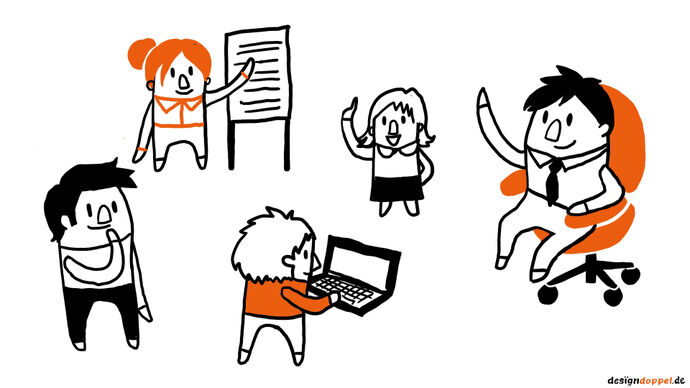Digital leadership
Digital technology is evolving the workplace. Key transformations include information technology, work flexibilization, and collaboration, especially distance collaboration. Crucially, the digitally transformed workplace is networked, because digital technology is connectivity technology. Networks create new possibilities for leadership, and leadership roles can be distributed widely in an organization, increasing flexibility and responsiveness, and enhancing individual initiative and democracy. The outcome is maximized innovation potential. Product ideas, work processes, and interpersonal structures: every successful idea and innovation can be quickly accessed and implemented.

Traditional organizations have usually been structured as hierarchies. In a hierarchy, leadership is exercised from above and transmitted linearly downwards. Leaders occupy unique positions in terms of ability to offer leadership (power), access to information, and connections to other members of the organization. By contrast, the digital organization uses technology to enhance networks and collaboration.

Networks create connections between people and enable access to knowledge. In a knowledge-dense environment, where information access and sharing are easy, networks distribute expertise efficiently. Networks boost collaboration and flexibility. They augment the responsiveness and innovation potential of a company by facilitating cooperation, shared decision making and interaction between anyone in its network.

The digital leader must enhance the effectiveness of these networks. Digital leaders schould support communication and dialogue, emphasizing factors such as goal setting and feedback. They can offer knowledge management, and they can support employees in learning, taking initiative, and innovating. Digital leaders can help employees not be alienated by technology, overwhelmed by knowledge, or burnt-out by the need to innovate.

Digital leaders must reshape leadership roles and functions to adapt to complex networked organizations. Old, hierarchical leadership models no longer apply. Instead, digital leadership requires networking on an equal footing with everyone, and the use of influence and knowledge brokering. Creating identities and stories is crucial so employees share a common goal. Leaders are responsible for a culture that supports innovation.
Assessing potential of the Beam telepresence system for remote leadership
An increasing globalization of the work force requires managers to communicate and lead remotely. This presents new challenges in building trust, motivating employees, and ensuring performance from afar. Airbus Group and LeadershipGarage are partnering to research the efficiency of using telepresence systems in remote leadership situations.
Learning from digital leadership pioneers
The digital workplace is characterized by flat hierarchies, network structures and redefined labor and management relations. To explore how to be successful in this new environment, the “Pioneers of Leadership” project studies companies that have outstanding innovation cultures and are already using the leadership approaches of tomorrow.
Sample
- Content analysis to identify subject companies
- 60 German companies identified as leadership pioneers
- Typically small companies
Method
- Interview study with leadership pioneers
- Critical incidence technique
- Companies describe in detail what is different about their leadership practices
Content
- Future concepts of innovative leadership
- Future leadership tasks and behaviors
- Company culture and values
This is an ongoing project, results will be presented here as they become available. Key insights already include the importance of networks and democracy in companies. There are new forms of networked leadership such as shared leadership and distributed leadership. These present challenges in utilizing feedback, assigning responsibilities, maintaining organizational identity, and preserving goal-orientation. Techniques and skills such as storytelling, influence, and knowledge management are crucial.
As the project progresses, ways to expand the practices of these small companies to larger organizations will also be explored.
